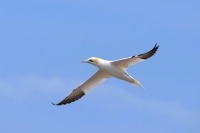
(Photo: Ralph Eldridge)
Northern Gannet
Morus bassanus
Adult northern gannets have a wingspan of 165 to 180 millimetres. They have a white body, black wings, a long thick beak, and rust colouration atop the head. Males and females look almost identical, but females are heavier. Juveniles are brown with white spots.
Authority
Linnaeus, 1758
Classification Details
Phylum: Chordata (chordates); Subphylum: Vertebrata (vertebrates); Class: Aves (birds).
Habitat
In North America, their range extends from Labrador to the Gulf of Mexico. The main breeding colonies are in the Gulf of St. Lawrence and off Newfoundland. They range up to 180 kilometres away to find food in adjacent waters, like the Bay of Fundy, to feed. In winter they migrate further south.
Diet
Eat surface schooling fish, like mackerel and herring, and squid. They plunge dive from a height of 10 to 40 metres, folding their wings backwards to enter the water like an arrow at speeds of over 100 kilometres per hour. They dive as deep as 15 metres but more commonly to depths of three to five metres. Large flocks of gannets may feed together. They will often grab wounded fish that other animals, such as whales or fishermen, have discarded. It is most common for them to forage in the early morning and late afternoon.
Reproduction
Sexes are separate. Pairs usually bond for life and return to the same nest site each year. They build nests made of mud, seaweed grass, and feathers. Parents take turns on the egg and looking after the chicks. The female lays a single egg, which the parents incubate under their feet for about 43 days. Newly hatched chicks are helpless with almost no down and little coordination. They grow rapidly and leave the nest at around 90 days old. Gannets breed in large colonies on cliffs and islands. There are six colonies in North America: three in the Gulf of St. Lawrence and three off Newfoundland. Scientists reported one pair was breeding on Whitehorse Island in the Quoddy Region.
Fun Facts
Gannet chicks grow very rapidly. At ten weeks old they can weigh up to 50% more than an adult. When leaving the nest, they jump off the cliff into the sea. They can't fly up from the sea surface as they are too heavy and have weak wing muscles, so they swim away instead.
References
Garthe S, Benvenuti S, and Montevecchi WA (2003) Temporal patterns of foraging activities of northern gannets, Morus bassanus, in the northwest Atlantic Ocean. Canadian Journal of Zoology 81(3), 453–461.
Mowbray T B (2020) Northern Gannet (Morus bassanus), version 1.0. In Birds of the World (S. M. Billerman, Editor). Cornell Lab of Ornithology, Ithaca, NY, USA. https://doi.org/10.2173/bow.norgan.01
Stauss C, Bearhop S, Bodey TW, Garthe S, Gunn C, Grecian WJ, Inger R, Knight ME, Newton J, Patrick SC, Phillips RA, Waggitt JJ and Votier SC (2012) Sex-specific foraging behaviour in northern gannets Morus bassanus: Incidence and implications. Marine Ecology Progress Series 457, 151–162.
Van Guelpen L, Pohle G, Vanden Berghe E and Costello MJ (2005) Marine Species Registers for the North Atlantic Ocean. World Wide Web electronic publication. http://www.vliz.be/vmdcdata/narms/
World Register of Marine Species. Morus bassanus (Linnaeus, 1758) – WoRMS Taxon Details. http://marinespecies.org/aphia.php?p=taxdetails&id=148776 Accessed online 22 January 2020.


